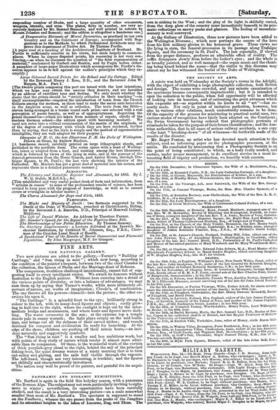FINE ARTS.
THE NATIONAL GALLERY.
Two new pictures are added to the gallery,—Turner's "Building of Carthage," and "Sun rising in mist " ; which now hang, according to the condition of the painter's bequest, between two of the chief Claudes in the collection, the Queen of Sheba and the Marriage-feast of Rebecca.
The comparison, doubtless challenged intentionally, cannot fail of sug- gesting itself to every intelligent visitor. We award its honours without hesitation to the English painter. Without here entering into a detail of the various points of diversity, or into a balance of advantages, we may sum them up by saying that Turner's works, while more intimately ob- servant of nature, are works of imagination; Claude's, of combination. The one throws all his powers—himself—into the picture ; the other ex- ercises his upon it.
"The Carthage" is a splendid feast to the eye; brilliantly strong in colour to the left, with its many-hued figures and objects ; coolly glow- ing in half-tint to the right, where the sunlight is kept out by the inter- mediate bridge and monuments, and where boats and figures move dark- ling. The water coruscates in the sun; at the extreme top a temple stands pale in sunny warmth; the light plays crisply on the mid build- ings, and brings out all the richness of their carved niches; and vessels destined for conquest and civilization lie ready for launching. At the edge of the shore, children are pushing off their mimic boats,—an inci- dent naturally and suggestively symbolic.
The "Sun rising in mist" is a smaller and less ambitious work, but with points of deep study of nature which render it almost more admi- rable than its companion. Of these, is the wonderful truth of the curtain of thick purplish-grey cloud to the right, behind the sail of the principal fishing-boat, the quiet dreamy waters of a misty morning that is to turn out sultry and glaring, and the sails half visible through the vapours. The left-hand, though not very interesting, is truthful; and the figures are skilfully and characteristically introduced. The nation may well be proud of its painter, and grateful for its acqui- sition.


























 Previous page
Previous page